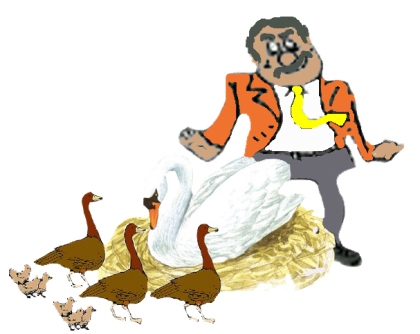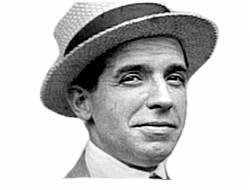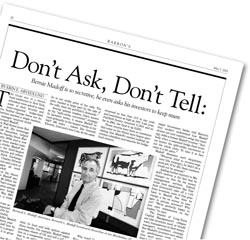Seeing only what we want to see…
May 6, 2009
One of the biggest obstacles in detecting the scam is that we sometimes see only what we want to see. What makes matters worse is that we don’t get much help from the experts. For example, many of the folks we depend on as financial analysts to analyze suffer from the same malady, as do many of the folks we rely on in the financial media to shine a bright light on whatever is weird in the financial markets.
The Madoff and Enron sagas offers great examples of this…
Applying the principles of The Duck School, Enron’s revenues defied common sense. In noting that Enron had apparently doubled its reported sales between 1999 and 2000, Dan Ackman, wrote this for Forbes:
“In its creation of revenue, if not profit, Enron was truly the corporation from another planet… Before it declared bankruptcy, Enron said it was on track to double revenue again… Had it done so, it would have become the second-largest corporation in the world in terms of sales.”
Something was weird. He asked how, in less than 18 months, the company could have gone from a relatively obscure energy-trading company to one of the largest companies in the world by revenue? And how could a company that was reporting such large revenues have no cash? In the first nine months of 2000, Enron had negative cash flow. How could a company operate without cash? Its debt was rising. Something was wrong…
Dan Ackman offered his take on the company’s numbers by using the analogy of an Olympic track coach:
“An uncritical reading of Enron’s inscrutable reports indicates it was running so much faster than everyone else. If an Olympic coach heard a report that an unknown runner had broken the world record for the mile by two seconds, he might be skeptical or wonder if the runner was on drugs. But if he had heard that the runner had run a mile in three minutes flat, 45 seconds faster than everyone else, he’d refuse to believe it. He’d say it was impossible. Or he’d say the watch was broken. When Enron made equally unlikely pronouncements no one seems to have asked a question of thought twice.”
Sadly, until it was too late, nobody took much notice of Dan Ackman and others in the financial media who shone a light on the wackiness that was Enron…
As for Madoff, as I’ve already been noted in an earlier post, Barron’s magazine smelled something in the air way back in 2001. In an article that year, Barron reported that it asked Bernie Madoff how he accomplished compound average annual returns of 15% for more than a decade. This made no sense. It was inconceivable to them how he could perform so consistently year in and year out. The 2001 Barron’s article describes how three option strategists for major investment banks just didn’t buy this. For them and for others, Madoff’s split strike strategy was not the whole story… Sadly, nobody paid attention.
What’s the moral here? Firstly, if something seems too good to be true, it might not be true… Secondly, don’t assume the so-called experts have done their homework, they might not have… Thirdly, trust yourself. If the explanations you hear make no sense, you might just be right. Don’t accept the inexplicable…
The Scam: The Rolex Test (Part 1)…
April 30, 2009
Here’s the question: Can you be a victim of a scam if you knew or should have known about the lie the scammers sold you? Can you pass the Rolex test?
Here’s the test:
Someone approaches you in a subway and offers you a Rolex. It looks like a Rolex, but it doesn’t feel like one. It is as light as a feather—quite unlike the Rolex watches that are sold for thousands of dollars in the stores. For you, you are told, the price is $50. Although neither of you actually mouth the words, you each know its fake.
Here’s the question: If you buy it, are you the victim of a scam? And can you later really claim outrage and surprise about what occurred?
The answer to both questions is “no”—you simply bought a fake Rolex. End of story…
In researching some of the larger more outrageous recent scams, it is almost impossible to believe that some of our finest and brightest didn’t recognize the lies. Enron’s Ken Lay and Jeff Skilling, for example, tried to make the case that they had no idea what was happening on their watch. They claimed they had no knowledge of the very schemes they hatched with Andrew Fastow, their CFO. They blamed anyone they could think of from their lawyers, accountants, Andrew Fastow and their other colleagues, on the one hand, to the financial media, on the other. These former darlings of Wall Street put forward a novel “I-am-an-idiot” defense in their criminal trials. Fortunately, sanity prevailed. Their juries didn’t buy it. …
In the Bernie Madoff saga, if any student enrolled in any business school in any part of the world was to claim to his professor that he could offer investors a consistent rate of return year in and year out for decades in good times and bad, he would be hooted out of class and would fail the course. Remarkably, this is precisely what Madoff claimed he could accomplish and did accomplish year in and year out for decades. He was the guy in the subway peddling the fake Rolex. And some of our very finest and brightest bought what he was selling. They claimed they had no idea it was fake. They claimed that they too were victims of his scam. Puleeez… All that happened was they bought a fake Rolex, knowing it was fake. They failed the Rolex test…
Late last year, I bookmarked an article on Citigroup and the financial meltdown by Thomas Friedman. As I thought about the Rolex test, I thought about his article, which is well worth reading. In discussing the financial meltdown in general and Citigroup in particular, he described how our finest, brightest and best-paid bankers were either “over-rated dopes who had no idea what they were selling, or greedy cynics who did know and turned a blind eye.” Sounds awfully like the guy in the subway who bought that Rolex…
The Scam: Accepting The Inexplicable…
April 29, 2009

Is it a duck or a swan?
If someone tells you that you are looking at a beautiful swan, but all you can see are three ugly ducks, all you know for sure is that one of you is wrong…
When you ask him why he thinks you are looking at a swan, and, as you listen to his explanation, you might remember what Groucho Marx said in a movie to a woman he was trying to con: “Who are you going to trust? Me or your own eyes?” Then again, you might not remember…
Despite what your eyes and mind are telling you, you might be tempted into accepting the swan guy’s explanation. After all, there’s a promised financial windfall at the end of the rainbow…
Here’s the scoop on this particular scenario: If the dude can’t provide you with a reasonable explanation—in a way that a reasonably literate drug-free 16-year old with a 3-minute attention span can understand, it isn’t your problem. It is the swan guy’s problem…
Take the examples of the Ponzi, Enron and Madoff scams. In each case, the scammer’s marks were offered seemingly inexplicable explanations. In each case, many of these marks turned away from common sense. They turned away from The Duck School and instead chose the prospect of getting rich. And when they lost a fortune, they were outraged—not at themselves for being such putzes, but at the scammers…
Carlo Ponzi

Carlo Ponzi
In 1919, Carlo Ponzi advertised a 50% return on investment in 90 days. As money flowed in from large and small investors, he knew he would have to come up with an explanation as to how he could offer such a large return at a time when nobody in the world could match this.
This was what he came up with: He claimed he had a network of agents in Europe that purchased depreciated European currencies and then converted those currencies into international postal coupons, which were then redeemed at face value in the United States in U.S. dollars. Needless to say, this was a total crock, but nobody cared—at least as long as they collected their 50% return…
Enron Corporation

Ken Lay
Enron knew it faced a problem. People didn’t know what it was doing. In Ken Lay’s letter to shareholders that accompanied Enron’s 1999 Annual Report, he addressed the problem with this gem:
“Enron is moving so fast that sometimes others have trouble defining us. But we know who we are.”
This had to be an enormous relief to shareholders and analysts who couldn’t figure out how Enron made money. This is how Enron’s 2000 Annual Report describes the company’s activities:
“Enron builds wholesale businesses through the creation of networks involving selective asset ownership, contractual access to third party assets and market-making activities.”
OK, presumably you now know what Enron actually does? If you don’t, you are in good company. In January 2001, Dan Ackman, a reporter for Forbes, read Enron’s financial reporting statements and reached this classic conclusion:
“Enron’s discussion of its finances reads like something written in German, translated to Chinese and back to English by way of Polish.”
The next month, much to the irritation of Enron’s senior management, Bethany McClean, a reporter for Fortune, reached the same conclusion:
“The company remains largely impenetrable to outsiders. How exactly does Enron make its money? Details are hard to come by… Analysts don’t seem to have a clue.”
Bernie Madoff

Barron's May 7, 2001 Article
Bernie Madoff was a worthy successor to Ponzi and Enron. Although the scam was only revealed in 2009, Barron’s magazine smelled something in the air way back in 2001. In an article that year, Barron reported that it asked Bernie Madoff how he accomplished compound average annual returns of 15% for more than a decade. He replied saying the strategy was “proprietary.”
One of Madoff’s hedge-fund-offering memorandums offered an explanation and described his split strike strategy in this way:
“Typically, a position will consist of the ownership of 30-35 S&P 100 stocks, most correlated to that index, the sale of out-of-money calls on the index and a the purchase of out-of-money puts on the index. The sale of the calls is designed to increase the rate of return, while allowing upward movement of the stock portfolio to the strike price of the calls. The puts, funded in large part by the sale of the calls, limit the portfolio’s downside.”
The 2001 Barron’s article describes how three option strategists for major investment banks just didn’t buy this. For them and for others, Madoff’s split strike strategy was not the whole story…
Despite all of this, those who invested with Ponzi, Enron, and Madoff all allowed their insecurity and greed to blind themselves. They accepted the seemingly inexplicable. They then claimed victimhood…
Does anyone have other examples of this?